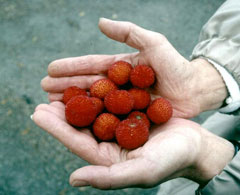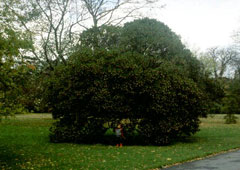 |
|
(c) 2010 Ken Fern & Plants For A Future |
 |
| (c) 2010 Ken Fern & Plants For A Future |
Translate this page:
Summary
Bloom Color: Pink, White.
Main Bloom Time: Early fall, Early winter, Late fall, Late winter, Mid fall, Mid winter. Form: Rounded.
Physical Characteristics

 Arbutus unedo is an evergreen Tree growing to 9 m (29ft) by 8 m (26ft) at a medium rate.
Arbutus unedo is an evergreen Tree growing to 9 m (29ft) by 8 m (26ft) at a medium rate.
See above for USDA hardiness. It is hardy to UK zone 7 and is not frost tender. It is in leaf all year, in flower from October to December, and the seeds ripen from October to December. The species is hermaphrodite (has both male and female organs) and is pollinated by Bees. The plant is self-fertile.
Suitable for: light (sandy) and medium (loamy) soils, prefers well-drained soil and can grow in heavy clay soil. Suitable pH: mildly acid, neutral and basic (mildly alkaline) soils. It can grow in semi-shade (light woodland) or no shade. It prefers dry or moist soil. The plant can tolerate maritime exposure.
It can tolerate atmospheric pollution.
UK Hardiness Map
US Hardiness Map
Synonyms
Plant Habitats
Woodland Garden Secondary; Sunny Edge; Dappled Shade;
Edible Uses
Edible Parts: Fruit
Edible Uses:
Fruit - raw or cooked. Sweet but insipid[2, 3, 5]. The Latin name 'unedo' means 'I eat one (only)' and suggests that the fruit is not very palatable[K], though another report says that the fruit is so delicious that a person only needs to eat one[245]. It does have a somewhat gritty skin, but the fruit itself has the texture of a lush tropical fruit and has a delicate pleasant flavour. For those people with sensitive taste buds, this is a fruit that can be enjoyed when eaten in moderate quantities[K]. The fruit contains about 20% sugars and can be used to make delicious and nourishing jams and preserves[7]. It is ripe in November/December and is about 15mm in diameter. When fully ripe it falls from the tree and so it is advisable to grow the plant in short grass in order to cushion the fall of the fruit[K].
References More on Edible Uses
Medicinal Uses
Plants For A Future can not take any responsibility for any adverse effects from the use of plants. Always seek advice from a professional before using a plant medicinally.
Antiseptic Astringent Diuretic Dysentery Urinary
The strawberry tree is little used in herbalism, though it does deserve modern investigation[268]. All parts of the plant contain ethyl gallate, a substance that possesses strong antibiotic activity against the Mycobacterium bacteria[268]. The leaves, bark and root are astringent and diuretic[7, 46, 268]. They are also a renal antiseptic[7] and so are of use in the treatment of affections of the urinary system such as cystitis and urethritis[254]. Their astringent action makes them of use in the treatment of diarrhoea and dysentery and, like many other astringent plants, a gargle can be made for treating sore and irritated throats[254]. The leaves are gathered in the summer and dried for later use[7]. The flowers are weakly diaphoretic[268].
References More on Medicinal Uses
The Bookshop: Edible Plant Books
Our Latest books on Perennial Plants For Food Forests and Permaculture Gardens in paperback or digital formats.

Edible Tropical Plants
Food Forest Plants for Hotter Conditions: 250+ Plants For Tropical Food Forests & Permaculture Gardens.
More

Edible Temperate Plants
Plants for Your Food Forest: 500 Plants for Temperate Food Forests & Permaculture Gardens.
More

More Books
PFAF have eight books available in paperback and digital formats. Browse the shop for more information.
Shop Now
Other Uses
Tannin Wood
Tannin is obtained from the leaves, bark and fruit[46, 61]. The bark contains 45% tannin[46]. Wood - used for turning, Greek flutes etc[89, 148]. It makes a good charcoal[4, 89, 148].
Special Uses
Espalier Food Forest Scented Plants
References More on Other Uses
Cultivation details
Landscape Uses:Container, Espalier, Pest tolerant, Hedge, Standard, Specimen. Requires a nutrient-rich well-drained moisture-retentive soil in sun or semi-shade and shelter from cold drying winds, especially when young[11, 200]. Grows well in heavy clay soils and in dry soils. Most species in this genus require a lime-free soil but this species is fairly lime tolerant[11, 200]. Succeeds in fairly exposed maritime positions[166, 200]. A tree in a very exposed position at Rosewarne in N. Cornwall was looking rather tattered in April 1987 but it was 4.5 metres tall and carrying a very good crop of immature fruit[K]. Tolerates industrial pollution[200]. Plants have withstood temperatures down to -16°c without injury at Kew[11]. They grow very well in S.W. England, fruiting well in Cornwall[49, 59]. Plants resent root disturbance and are best placed in their final positions whilst young[11, 134]. Give them some protection in their first winter. The strawberry tree flowers in November and December, the fruit takes 12 months to ripen and so the tree carries both mature fruit and flowers at the same time and is incredibly beautiful at this time[K]. The flowers have a soft honey scent[245]. There are a number of named varieties[183] developed for their ornamental value. 'Elfin King', 'Croomei' and 'Rubra' are all small forms that fruit well when small[182]. The variety 'Rubra' was 1.2 metres tall at Kew in late 1990 and was laden down with fruits and flowers[K]. 'Elfin King' only reaches a height of 1 metre, comes into bearing when young and fruits well[183]. It is ideal for container culture[183]. 'Croomei' is said to be a more reliable fruiting form[49]. Special Features:Attracts birds, Not North American native, Attractive flowers or blooms. The plant is heat tolerant in zones 9 through 6. (Plant Hardiness Zones show how well plants withstand cold winter temperatures.
Plant Heat Zones show when plants would start suffering from the heat.
The Plant Heat Zone map is based on the number of "heat days" experienced in a given area where the temperature climbs to over 86 degrees F (30°C).
At this temperature, many plants begin to suffer physiological damage. Heat Zones range from 1 (no heat days) to 12 (210 or more heat days).
For example Heat Zone. 11-1 indicates that the plant is heat tolerant in zones 11 through 1.) For polyculture design as well as the above-ground architecture (form - tree, shrub etc. and size shown above) information on the habit and root pattern is also useful and given here if available. The plant growth habit is multistemmed with multiple stems from the crown [1-2]. In garden design, as well as the above-ground architecture of a plant, root structure considerations help in choosing plants that work together for their optimal soil requirements including nutrients and water. The root pattern is branching: a heart root, dividing from the crown into several primary roots going down and out [2-1].
References Carbon Farming Information and Carbon Sequestration Information
Temperature Converter
Type a value in the Celsius field to convert the value to Fahrenheit:
Fahrenheit:
The PFAF Bookshop
Plants For A Future have a number of books available in paperback and digital form. Book titles include Edible Plants, Edible Perennials, Edible Trees,Edible Shrubs, Woodland Gardening, and Temperate Food Forest Plants. Our new book is Food Forest Plants For Hotter Conditions (Tropical and Sub-Tropical).
Shop Now
Plant Propagation
Seed - best surface sown in a cold frame as soon as it is ripe. Stored seed should be soaked for 5 - 6 days in warm water and then surface sown in a shady position in a greenhouse[78]. Do not allow the compost to become dry. 6 weeks cold stratification helps[134]. The seed usually germinates well in 2 - 3 months at 20°c[134]. Seedlings are prone to damp off[184], they are best transplanted to individual pots as soon as they are large enough to handle and should be kept well ventilated. Grow them on in a greenhouse for their first winter and then plant out in late spring after the last expected frosts[K]. Basal cuttings in late winter[200]. Cuttings of mature wood of the current season's growth, November/December in a frame. Poor percentage[78]. Layering of young wood - can take 2 years[1, 200].
Other Names
If available other names are mentioned here
Native Range
TEMPERATE ASIA: Lebanon, Syria, Turkey,Cyprus. EUROPE: Ireland, Ukraine, Albania, Bulgaria, Greece (incl. Crete), Croatia, Italy (incl. Sardinia, Sicily), Spain (incl. Baleares), France (incl. Corsica), Portugal, AFRICA: Algeria, Morocco, Tunisia.
Weed Potential
Right plant wrong place. We are currently updating this section.
Please note that a plant may be invasive in one area but may not in your area so it's worth checking.
Conservation Status
IUCN Red List of Threatened Plants Status :

Growth: S = slow M = medium F = fast. Soil: L = light (sandy) M = medium H = heavy (clay). pH: A = acid N = neutral B = basic (alkaline). Shade: F = full shade S = semi-shade N = no shade. Moisture: D = dry M = Moist We = wet Wa = water.
Now available:
Food Forest Plants for Mediterranean Conditions
350+ Perennial Plants For Mediterranean and Drier Food Forests and Permaculture Gardens.
[Paperback and eBook]
This is the third in Plants For A Future's series of plant guides for food forests tailored to
specific climate zones. Following volumes on temperate and tropical ecosystems, this book focuses
on species suited to Mediterranean conditions—regions with hot, dry summers and cool, wet winters,
often facing the added challenge of climate change.
Read More
Expert comment
Author
L.
Botanical References
1117200
Links / References
For a list of references used on this page please go here
Readers comment